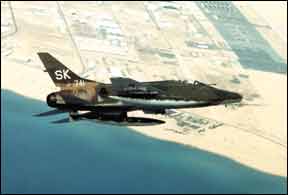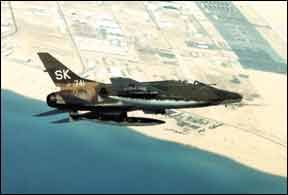My older brother, Vincent, flying the big airplanes for TWA, had an easily remembered but profound saying: “check and doublecheck.” Basically, it meant to make sure all actions in the cockpit were given a second, or even a third, look, ensuring the proper actions had indeed been made. I vividly remember an occasion when that saying saved my life.

288
I was flying an F-100 on a test mission out of Eglin Air Force Base, dropping some experimental high explosive bombs. One of the bombs did not drop, even though I had sent the release signal. The result was a very hazardous condition, called a “hung bomb.” The bomb might fall off at any time.
I alerted Eglin tower, calling for an emergency, straight-in approach and landing from over the water to avoid populated areas. I had another concern as well: If the bomb fell off during my landing approach, it probably would explode when it hit the ground—right below me. Not a comforting thought.
With these issues on my mind, I really didn’t need what happened next. As I approached the runway, slowing to final approach speed, something didn’t seem right. My attitude seemed a bit nose-high for my airspeed, similar to making a landing with the flaps up. Of course they were down! How could I make a mistake like that?
Just to make sure the flaps were down, I gave a quick glance at my flap indicator…check. My eyes told me the landing flaps were down. They had to be; if they weren’t, I would soon stall and mush into the ground short of the runway and too low to eject.
But things still didn’t feel right. So, just to make sure the flaps were down, I looked out at the wings to check their position visually…doublecheck. My eyes again told me the flaps were down. But the aircraft’s attitude still didn’t seem right, and I was rapidly approaching the runway.
My eye were now busy outside the cockpit, so my hands began their own “doublecheck” by reaching for the flap handle. Boy, was I surprised—actually elated—when my fingers told me the flap switch was in the up position. So, that’s what was wrong!
I quickly put down the flaps, gratefully achieved the normal landing attitude my mind had been searching for and made an uneventful landing, retaining the hung bomb throughout. Another routine flight completed.
How could my eyes have lied? As I mulled over that question, I realized they hadn’t: My mind had seen just what it wanted to see. If my fingers hadn’t continued to doublecheck for an errant configuration, and I had continued to slow down, the outcome might have been a big fireball just short of the runway. Every time I drive by that area, I am reminded of that day. Thank you, brother.
—Larry Van Pelt




